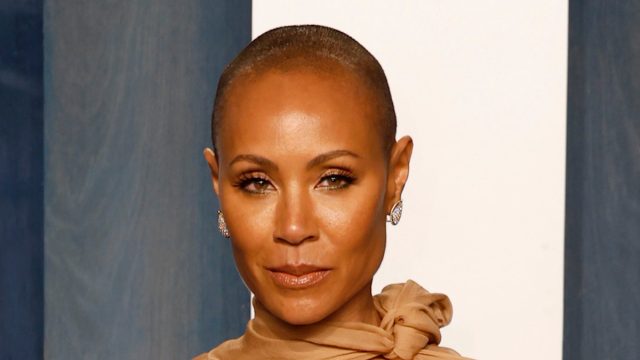Jada Pinkett Smith's Hair Loss is Caused by Alopecia

Usually it is the red carpet fashions or the moving acceptance speeches that people are chattering about post-Oscars. However, this year's main talking point undoubtedly surrounded the incident between Will Smith and Chris Rock, when the comedian presenter poked fun at Jada Pinkett Smith's bald head, referring to her as "G.I. Jane." The comment enraged Smith, as his beloved wife didn't choose to shave her head as a fashion statement: She actually suffers from alopecia, a health condition that causes you to lose your hair. What exactly is alopecia and how has the actress embraced the autoimmune disorder? Keep reading to find out.
She Revealed Her Hair Loss in 2018

The actress first opened up about her health condition during a 2018 episode of her talk show, Red Table Talk. "A lot of people have been asking why I've been wearing turbans. Well, I haven't talked about it. It's not easy to talk about, but I am going to talk about it," she said, adding that she was facing "issues with hair loss." "It was terrifying when it first started. I was in the shower one day and had just handfuls of hair in my hands and I was just like, 'Oh my god, am I going bald?'" she continued. "It was one of those times in my life where I was literally shaking in fear. That's why I cut my hair, and why I continue to cut it," she said. "My hair has been a big part of me," she continued. "Taking care of my hair has been a beautiful ritual and having the choice to have hair or not. And then one day to be like, 'Oh my god, I might not have that choice anymore.'"
She Shaved Her Head in 2021
In July 2021, Jada fully embraced her hair loss and opted to shave her head entirely. "Willow made me do it because it was time to let go BUT … my 50's are bout to be Divinely lit with this shed," she wrote in an Instagram post, showing off her new look.
She Has Been Open About Her Symptoms
In December 2021, the actress shared an update about her condition via Instagram, revealing a "sudden" new symptom she was coping with: A bald line patch. "Mama's gonna have to take it down to the scalp so nobody thinks she got brain surgery or something😜" she captioned the video. "Me and this alopecia are going to be friends … period!😆" "Now at this point, I can only laugh. Y'all know I've been struggling with alopecia and just all of a sudden one day, look at this line right here. Look at that," she exclaims with a smile on her face, pointing out the new manifestation of her condition. "So it just showed up like that and this is going to be a little bit more difficult for me to hide. So I thought I'd just share it so y'all are not asking any questions," she said in the video. She also revealed how she was going to embrace the symptom with self-love. "But you know mama's going to put some rhinestones in there. I'm going to make me a little crown. That's what mama's going to do," she added.
Alopecia Is an Autoimmune Disorder

The American Academy of Dermatology Association explains that alopecia areata is an autoimmune disorder that develops when the body attacks its own hair follicles, resulting in hair loss anywhere on the body. "Many people who develop alopecia areata develop a round or oval bald patch on their scalp," they say.
There Are Three Types of Alopecia

Per the AADA there are three types of alopecia: Alopecia areata, totalis, and universalis. The most common, areata, usually involves "patchy baldness," most commonly manifesting itself on the scalp, beard area, eyebrows, eyelashes, armpits, inside the nose, or ears. Totalis, as the name suggests, causes an individual to lose all hair on the scalp. The rarest form, universalis, is where an individual loses all body hair. It can also occur in cycles.
It Can Be a Chronic Condition

Unfortunately, there are many uncertainties when it comes to the condition, per the AADA. Sometimes hair will regrow on its own without treatment, and sometimes it won't. And even if it does, it may or may not fall out again. Furthermore, it isn't clear what causes alopecia, although there may be a genetic component. For more on the condition, see this report on our sister site Eat This, Not That! Health.




